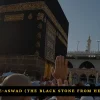Hajr e Aswad is a symbol of Islam that is revered by Muslims. This black stone is located in the eastern corner of the Holy Kaaba, which is the house of Allah. It is the sacred stone at the beginning and end of Tawaf, the mandatory rite of the Hajj and Umrah pilgrimages. Many people, including Prophet Muhammad, other well-known Prophets, the Sahabah, and millions of pilgrims, traveled to perform the religious journeys of Hajj and Umrah, where they prayed for and received Allah’s blessings. A crucial aspect of these spiritual journeys is honoring the Black Stone in Kaaba. The Arabs’ pre-Islamic religion is likely the source of the Black Stone. It is currently divided into three significant pieces, some of which are broken, surrounded by a stone ring, and held together by a silver band. According to an Islamic legend Hajr e Aswad was given to Adam when he fell from paradise. At first, it was white, but the pilgrims’ kissing and touching caused it to turn black.
HISTORY OF THE BLACK STONE:
The Black Stone is more significant because, according to a story, when Ibrahim AS was building the Holy Kaaba, God’s house, for spirituality and worship, it appeared that the stones needed to complete the wall were lacking. To complete the Holy Wall of the Kaaba, Prophet Ibrahim sent his son Prophet Ismail A.S to look for a suitable stone to fill the void. He noticed an already-placed shiny white stone when he returned empty-handed. He was informed by Ibrahim AS that Jibreel was the one who gave him the unique stone. The Qarmatians, an extremist Muslim sect from eastern Arabia, stole the Hajar al-Awad around 930 CE. They took the sacred stone to their base in Ihsaa after looting Makkah and vandalizing the city with bodies. A historian claims that the Hajar al-Awad was brought back to its original site in 952 CE. When the Holy Kaaba reached the position of the Black Stone in Makkah during the reconstruction process, there was a conflict among the masses. Who was deserving of the Black Stone’s return to its original location was the subject of contention. Abu UmayyaIbn al-Mugheera, their elder, concluded and asked the Quraysh, a mercantile Arab tribe that ruled Makkah and its Kaaba, to agree on who would be the first person through the Bani Shaybah Gate, the central northern gate into the Kaaba area. The Prophet was the one who entered and returned the Black Stone to its original location.
RITUAL ROLE OF BLACK STONE:
Pilgrims repeatedly recite the Takbir, or “God is Greatest,” as they kiss, touch, or raise their hands in front of the Black Stone as part of the Islamic ritual. They do this by walking around the Kaaba seven times in a counterclockwise direction (Tawaf), imitating Muhammad’s steps. They perform Islam after each circuit and may approach the Black Stone to exchange a tawaf kiss.
Muslims from all over the world come to Makkah to kiss the rock, which not only attracts Muslims but also draws them to the area. This Black Stone is the only rock remaining from the original Kaaba structure that Hazrat Ibraham and Hazrat Ismail constructed. It is the only stone that has stood the test of time during all of Kaaba’s upheavals and events.
The most revered stone in the world is this component of the Kaaba. Because the Prophet Mohammad kissed and touched it, Muslims want to do the same. Kissing is an act of love rather than a duty because it is something to honor and take pride in.





